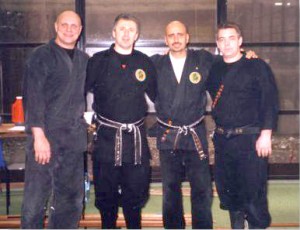Shin Gi Tai Ken Ichi Yotsu
From Shiro Kuma's Blog by kumablog
For years sensei has been repeating that our movements are done with 躯, Karada, the body. To help the students understand this, we keep telling them to develop footwork. The pedagogical reason to it is that if we tell them “move your body” they will not know what to do. But by speaking of the legs we force them to move the body.
In the tenchijin there is this concept of “Ken Tai Ichi Jô” or “moving the body and the weapon (armed or unarmed) as one”. Yesterday sensei repeated this “Ken Tai Ichi Jô” concept during his class.
To me it was echoing a more complete concept he introduced last Sunday. This new concept was: 心技体剣一四, “Shin Gi Tai Ken Ichi Yotsu”. To understand this, you have to know that sensei is teaching the ninja ken these days. Sunday the whole class was about 一閃剣, Issen Ken, and yesterday about 一刀 投げ, Ittō Nage.
“Shingitai” and “Yotsu” are concepts borrowed from Sumo wrestling*, where full body movements are required. By adding the “Ken” Sensei somehow connected the 3 aspects of Shingitai to the Ken, turning the “3” into “4”.
Hence the “Ichi Yotsu”, is the unity of (the four): shin gi tai ken.
Once the four are connected you are one. And because you are one, you can become zero. I know that this binary approach to 実戦, Jissen (actual fighting, true fight) may look strange to many practitioners but I can assure you that this is exactly the feeling you have when sensei is using you as uke.
Sensei asked me to be his uke a few times on Sunday and Tuesday and each time he was blocking my attacks (Jodan Kiri, tsuki) with his sword, there was no sword movement that I could perceive, each time head doing it with the body. To make myself clear sensei was physically deflecting or blocking my sword with his sword, but the only thing I could feel was his body movement. There was no clash, no strength just a simple Stephen would make, rendering my attacks useless.
Sensei being zero, his sword was a natural extension of his body. His movements were so natural that no intention, no show of power could be felt from my side. Each time it was like fighting a ghost. In fact, he spoke a few times about becoming a ghost to your opponent. “It is Kage no Shinobu” he explained layer saying that we had to move like a shadow.
On the technical side, the Issen Ken (the sword moves in a flash) and ittō Nage (throwing the sword) were done so softly that there was no time for me to counter his actions. There was nothing. One moment I was attacking, the next I was dead.
This “Ken Tai Ichi Jô” or should I say “Shin Gi Tai Ken Ichi Yotsu” is the essence of sword fighting and the purest expression of Shingin Budō and this is where we are now in the Bujinkan.
______________
* Sumo:
心技体, shingitai : three qualities of a sumo wrestler: heart, technique, physique
四つ相撲, Yotsu zumo: sumo wrestling in which both wrestlers grasp the other’s belt with both hands














